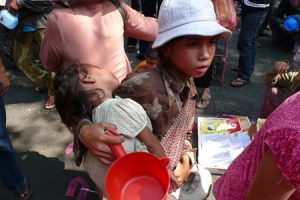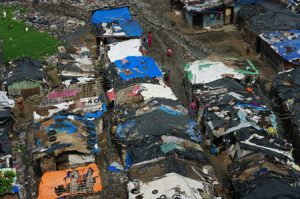Global Wealth and Poverty
- Understand the differences between relative, absolute, and subjective poverty
- Describe the economic situation of some of the world’s most impoverished areas
- Explain the cyclical impact of the consequences of poverty

What does it mean to be poor? Does it mean being a single mother with two kids in New York City, waiting for the next paycheck in order to buy groceries? Does it mean living with almost no furniture in your apartment because your income doesn’t allow for extras like beds or chairs? Or does it mean having to live with the distended bellies of the chronically malnourished throughout the peripheral nations of Sub-Saharan Africa and South Asia? Poverty has a thousand faces and a thousand gradations; there is no single definition that pulls together every part of the spectrum. You might feel you are poor if you can’t afford cable television or buy your own car. Every time you see a fellow student with a new laptop and smartphone you might feel that you, with your ten-year-old desktop computer, are barely keeping up. However, someone else might look at the clothes you wear and the calories you consume and consider you rich.
Types of Poverty
Social scientists define global poverty in different ways and take into account the complexities and the issues of relativism described above.
- Relative poverty is a state of living where people can afford necessities but are unable to meet their society’s average standard of living.
- Absolute poverty lack even basic necessities, which typically include adequate food, clean water, safe housing, and access to healthcare.
Absolute poverty is defined by the World Bank (2014a) as when someone lives on less than $1.25 a day. According to the most recent estimates, in 2011, about 17 percent of people in the developing world lived at or below $1.25 a day, a decrease of 26 percent compared to ten years ago, and an overall decrease of 35 percent compared to twenty years ago. A shocking number of people––88 million––live in absolute poverty, and close to 3 billion people live on less than $2.50 a day (Shah 2011). If you were forced to live on $2.50 a day, how would you do it? What would you deem worthy of spending money on, and what could you do without? How would you manage the necessities—and how would you make up the gap between what you need to live and what you can afford?

What do the driver of an unlicensed cab in New York, a piecework seamstress working from her home in Mumbai, and a street tortilla vendor in Mexico City have in common? They are all members of the underground economy, a loosely defined unregulated market unhindered by taxes, government permits, or human protections. Official statistics before the worldwide recession posit that the underground economy accounted for over 50 percent of nonagricultural work in Latin America; the figure went as high as 80 percent in parts of Asia and Africa (Chen 2001). The underground economy has never been viewed very positively by global economists. After all, its members don’t pay taxes, don’t take out loans to grow their businesses, and rarely earn enough to put money back into the economy in the form of consumer spending. Within the context of this recession, some see the underground economy as a key player in keeping people alive.
Global Feminization of Poverty
In some ways, the phrase “global feminization of poverty” says it all: around the world, women are bearing a disproportionate percentage of the burden of poverty. This means more women live in poor conditions, receive inadequate healthcare, bear the brunt of malnutrition and inadequate drinking water, and so on. Throughout the 1990s, data indicated that while overall poverty rates were rising, especially in peripheral nations, the rates of impoverishment increased for women nearly 20 percent more than for men (Mogadham 2005).
Why is this happening? While myriad variables affect women’s poverty, research specializing in this issue identifies three causes (Mogadham 2005):
- The expansion in the number of female-headed households
- The persistence and consequences of intra-household inequalities and biases against women
- The implementation of neoliberal economic policies around the world
While women are living longer and healthier lives today compared to ten years ago, around the world many women are denied basic rights, particularly in the workplace. In peripheral nations, they accumulate fewer assets, farm less land, make less money, and face restricted civil rights and liberties. Women can stimulate the economic growth of peripheral nations, but they are often undereducated and lack access to credit needed to start small businesses.
Consequences of Poverty
The poor often experience inadequate healthcare, limited education, and the inaccessibility of birth control. But those born into these conditions are incredibly challenged in their efforts to break out since these consequences of poverty are also causes of poverty, perpetuating a cycle of disadvantage. According to sociologists Neckerman and Torche (2007) in their analysis of global inequality studies, the consequences of poverty are many. Neckerman and Torche have divided them into three areas.
- poverty is difficult to reverse
- it has effects on mental and physical health
- it relates to a prevalence in crime
Slavery refers to any situation in which people are sold, treated as property, or forced to work for little or no pay. Just as in the pre-Civil War United States, these humans are at the mercy of their employers. Chattel slavery, the form of slavery once practiced in the American South, occurs when one person owns another as property. Child slavery, which may include child prostitution, is a form of chattel slavery. In debt bondage, or bonded labor, the poor pledge themselves as servants in exchange for the cost of basic necessities like transportation, room, and board. In this scenario, people are paid less than they are charged for room and board. When travel is required, they can arrive in debt for their travel expenses and be unable to work their way free, since their wages do not allow them to ever get ahead.
The global watchdog group Anti-Slavery International recognizes other forms of slavery: human trafficking (in which people are moved away from their communities and forced to work against their will), child domestic work and child labor, and certain forms of servile marriage, in which women are little more than chattel slaves (Anti-Slavery International 2012).
Summary
When looking at the world’s poor, we first have to define the difference between relative poverty, absolute poverty, and subjective poverty. While those in relative poverty might not have enough to live at their country’s standard of living, those in absolute poverty do not have, or barely have, basic necessities such as food. Poverty has numerous negative consequences, from increased crime rates to a detrimental impact on physical and mental health.
Section Quiz
Short Answer
Consider the concept of subjective poverty. Does it make sense that poverty is in the eye of the beholder? When you see a homeless person, is your reaction different if he or she is seemingly content versus begging? Why?
Think of people among your family, your friends, or your classmates who are relatively unequal in terms of wealth. What is their relationship like? What factors come into play?
Go to your campus bookstore or visit its web site. Find out who manufactures apparel and novelty items with your school’s insignias. In what countries are these produced? Conduct some research to determine how well your school adheres to the principles advocated by USAS.
Contemporary Research
Students often think that the United States is immune to the atrocity of human trafficking. Check out the following link to learn more about trafficking in the United States: http://openstaxcollege.org/l/human_trafficking_in_US
For more information about the ongoing practices of slavery in the modern world click here: http://openstaxcollege.org/l/anti-slavery
References
Anti-Slavery International. 2012. “What Is Modern Slavery?” Retrieved January 1, 2012 (http://www.antislavery.org/english/slavery_today/what_is_modern_slavery.aspx).
Barta, Patrick. 2009. “The Rise of the Underground.” Wall Street Journal, March 14. Retrieved January 1, 2012 (ttp://online.wsj.com/article/SB123698646833925567.html).
Buvinić, M. 1997. “Women in Poverty: A New Global Underclass.” Foreign Policy, Fall (108):1–7.
Chen, Martha. 2001. “Women in the Informal Sector: A Global Picture, the Global Movement.” The SAIS Review 21:71–82
Chronicle of Higher Education. 2006. “Nearly Nude Penn State Students Protest Sweatshop Labor.” March 26. Retrieved January 4, 2012 (http://chronicle.com/article/Nearly-Nude-Penn-Staters/36772).
Fajnzylber, Pablo, Daniel Lederman, and Norman Loayza. 2002. “Inequality and Violent Crime.” Journal of Law and Economics 45:1–40.
International Labour Organization. 2012. “High Unemployment and Growing Inequality Fuel Social Unrest around the World.” Retrieved November 7, 2014 (http://www.ilo.org/global/about-the-ilo/newsroom/comment-analysis/WCMS_179430/lang–en/index.htm).
Neckerman, Kathryn, and Florencia Torche. 2007. “Inequality: Causes and Consequences.” Annual Review of Sociology 33:335–357.
Shah, Anup. 2011. “Poverty around the World.” Global Issues. Retrieved January 17, 2012 (http://www.globalissues.org/print/article/4).
U.S. Department of State. 2011a. “Background Note: Argentina.” Retrieved January 3, 2012 (http://www.state.gov/r/pa/ei/bgn/26516.htm).
U.S. Department of State. 2011b. “Background Note: China.” Retrieved January 3, 2012 (http://www.state.gov/r/pa/ei/bgn/18902.htm#econ).
U.S. Department of State. 2011c. “Background Note: Rwanda.” Retrieved January 3, 2012 (http://www.state.gov/r/pa/ei/bgn/2861.htm#econ).
USAS. 2009. “Mission, Vision and Organizing Philosophy.” August. Retrieved January 2, 2012 (http://usas.org).
World Bank. 2013. “Middle East and North Africa.” Retrieved November 7, 2014 (http://web.worldbank.org/WBSITE/EXTERNAL/COUNTRIES/MENAEXT/0,,menuPK:247619~pagePK:146748~piPK:146812~theSitePK:256299,00.html).
World Bank. 2014e. “Poverty Overview.” Retrieved November 7, 2014 (http://www.worldbank.org/en/topic/poverty/overview).
the state where one is barely able, or unable, to afford basic necessities
an unregulated economy of labor and goods that operates outside of governance, regulatory systems, or human protections
the state of poverty where one is unable to live the lifestyle of the average person in the country

